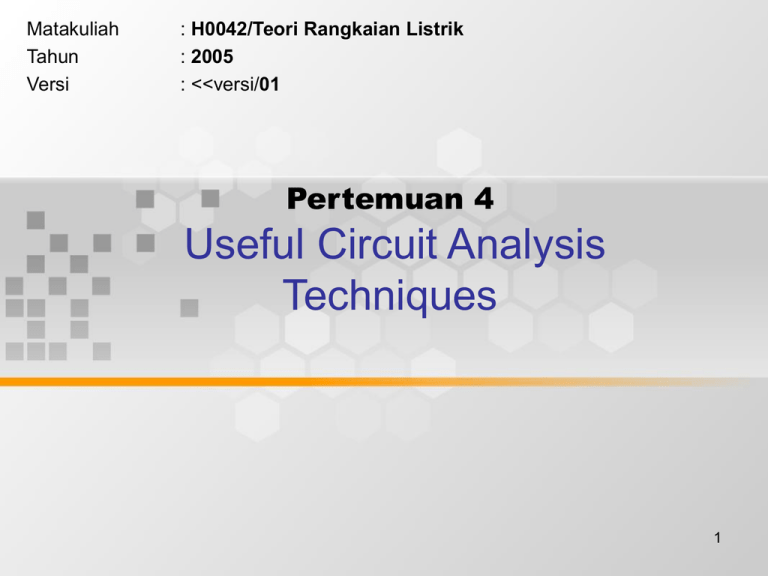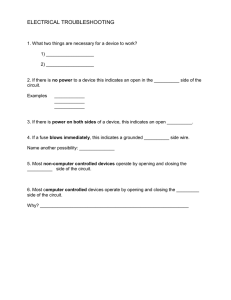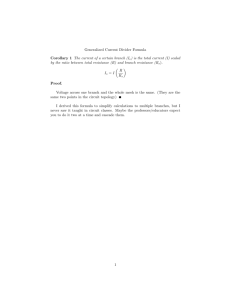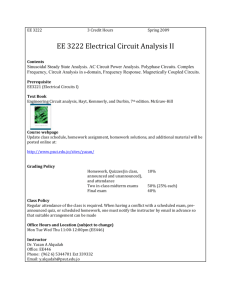
Matakuliah
Tahun
Versi
: H0042/Teori Rangkaian Listrik
: 2005
: <<versi/01
Pertemuan 4
Useful Circuit Analysis
Techniques
1
Learning Outcomes
Pada akhir pertemuan ini, diharapkan mahasiswa
akan mampu :
• Menguraikan rangkaian linier dengan
metode superposisi
• Menghitung variabel arus dan tegangan
pada elemen R dengan metode
superposisi.
2
Outline Materi
• Materi 1 : pengenalan metode analisa
superposisi
• Materi 2 : pegenalan metode analisa
transformasi sumber.
• Materi 3 : aplikasi metode analisa
superposisi
• Materi 4 : aplikasi metode analisa
superposisi
3
Chapter 5 Useful Circuit Analysis
Techniques
Fig. 5.1
A circuit with two independent current sources.
Fig. 5.2
(a) A voltage source set to zero acts like a short circuit…
Fig. 5.3
Circuit from Example 5.1 (Superposition Example).
Fig. 5.6
Circuit from Example 5.3 (Superposition Example).
Fig. 5.13
(and 5.14) Practical sources.
Fig. 5.21
(a) A complex network including a load resistor RL.
Fig. 5.22
Figs. from Example 5.6 (Thévenin/ Norton Equivalents).
Fig. 5.30
Circuit from Example 5.10.
Engineering Circuit Analysis Sixth Edition
W.H. Hayt, Jr., J.E. Kemmerly, S.M. Durbin
Copyright © 2002 McGraw-Hill, Inc. All Rights Reserved.
4
A circuit with two
independent
current sources.
W.H. Hayt, Jr., J.E. Kemmerly, S.M. Durbin, Engineering Circuit Analysis, Sixth Edition.
Copyright ©2002 McGraw-Hill. All rights reserved.
5
• SUPERPOSITION
• The superposition principle applies to phasor responses
only if all of the independent sources driving the circuit
have the same frequency. That is , when the input
sources have the same frequency, we can find the
phasor response due to each source acting alone and
obtain the total response by adding the individual
phasors. If the sources have different frequencies, then
superposition can still be used but its application is
different. With different frequency sources, each source
must be treated in a separate steady-state analysis
because the element impedances change with
frequency. The phasor response for each source must
be changed into waveforms and then superposition
applied in the time domain. In other words, the
superposition principle always applies in the time
domain. It also applies in the phasor domain when all
independent sources have the same frequency. The
6
following examples illustrate both cases.
(a) A voltage
source set to zero
acts like a short
circuit. (b) A
current source
set to zero acts
like an open
circuit.
W.H. Hayt, Jr., J.E. Kemmerly, S.M. Durbin, Engineering Circuit Analysis, Sixth Edition.
Copyright ©2002 McGraw-Hill. All rights reserved.
7
Use superposition to find the current ix.
W.H. Hayt, Jr., J.E. Kemmerly, S.M. Durbin, Engineering Circuit Analysis, Sixth Edition.
Copyright ©2002 McGraw-Hill. All rights reserved.
8
Use superposition to find the current ix.
W.H. Hayt, Jr., J.E. Kemmerly, S.M. Durbin, Engineering Circuit Analysis, Sixth Edition.
Copyright ©2002 McGraw-Hill. All rights reserved.
9
(a) A general practical voltage source
connected to a load resistor RL. (b) The
terminal characteristics compared to an
ideal source.
(a) A general practical current source
connected to a load resistor RL. (b) The
terminal characteristics compared to an
ideal source.
W.H. Hayt, Jr., J.E. Kemmerly, S.M. Durbin, Engineering Circuit Analysis, Sixth Edition.
Copyright ©2002 McGraw-Hill. All rights reserved.
10
.
Problem 3. Use superposition to find the steady-state
current i(t) in Fig. 8-23 for R=10k,L=200mH,
vS1=24cos20000t V, and vS2=8cos(60000t+30).
• SOLUTION:
• In this example the two sources operate at different
frequencies. With source no. 2 off, the input phasor is
Vs1 = 240V at a frequency of =20 krad/s . At this
frequency the equivalent impedance of the inductor and
resistor is
11
The phasor current due to source no.1 is
With source no.1 off and no.2 on, the input phasor VS2 =8 8
30
at a frequency of
= 60 krad/s. At this frequency the equivalent impedance of the
inductor and resistor is
12
The phasor current due to source no.2 is
• The two input sources operate at different frequencies,
so that phasors responses I1 and I2 cannot be added to
obtain the overall response. In this case the overall
response is obtained by adding the corresponding timedomain functions.
13
Problem 4.Use superposition to find the value of vx in the circuit of Fig.
5.44.
Problem 5. Apply superposition to the circuit of Fig.
5.45 to find i3.
14
RESUME
• Tegangan dan arus yang diserap oleh
beban pada rangkaian listrik dapat
diidentifikasi dengan penyederhanaan
rangkaian berdasarkan transformasi
sumber.
15




